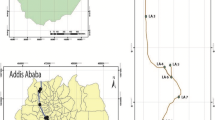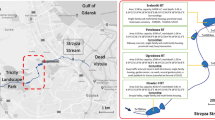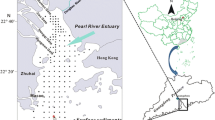Abstract
Estuarine systems adjacent to urban areas are at risk of contamination by contaminants from anthropogenic sources, such as heavy metals. We anticipated that the sediments of the Swan River estuary, which runs through metropolitan Perth in Western Australia, would show metal contamination related to industrialization and inputs of stormwater. Total Cu, Pb and Cd concentrations, and Cu, Pb, Cr and Zn inoperationally-defined fractions, were determined inseparate sampling exercises in near-shore sediments ofthe upper Swan River estuary.Total metal concentrations in sediments were not high (maximum values of 297 mg kg-1 for Cu, 184 mg kg-1 for Pb and 0.9 mg kg-1 for Cd) when compared with Australian environmental assessmentguidelines for soils. On the basis of linear regressions between sediment metal concentrations andphysicochemical properties of the sediments (pH, organic carbon, particle size distribution), no single parameter could explain the variation in metal concentrations for all metals. Sediment organic carbon content was positively correlated with Cu concentration; Cu concentrations also increased significantly with increasing clay content anddecreasing sand content. Pb concentrations showed a significant increase with increasing sediment pH, and were approximately three-fold higher in sediments adjacent to stormwater drain outfalls than in sediments remote from drains; no such effect was observed for Cu or Cd. No effect of distance downstream was observed. Sequential extraction of sediments showed that most of the metals were in relatively immobile forms, for example bound to Feoxides, or only extractable by aqua regia. The enhanced concentrations of Pb near stormwater outfalls suggest that vehicle-derived Pb may be an important contributor of Pb to the estuary.
Similar content being viewed by others
References
Allison, L. E.: 1965, 'Organic Carbon', in C. A. Black, D. D. Evans, J. L. White, L. E. Ensminger, F. E. Clark and D. C. Dinauer (eds.), Methods of Soil Analysis. Part 2. Chemical and Microbiological Properties, American Society of Agronomy, Madison, WI, U.S.A., p. 1372.
Alloway, B. J. (ed.): 1995. Heavy Metals in Soils, Blackie Academic and Professional, Glasgow.
ANZECC/NHMRC: 1992, Australian and New Zealand Guidelines for the Assessment and Management of Contaminated Sites, Australian and New Zealand Environment and Conservation Council/National Health and Medical Research Council, Canberra.
Birch, G. F.: 1996, Estuarine, Coastal and Shelf Science 42, 31.
Birch, G. F., Evenden, D. and Teutsch, M. E.: 1996, Environmental Geology 28, 169.
Bolt, G. H. and van Riemsdijk, W. H.: 1987, 'Surface Chemical Processes in Soil', in W. Stumm (ed.), Aquatic Surface Chemistry, Wiley-Interscience, New York, pp. 127–164.
Chao, T. T.: 1984, Journal of Geochemical Exploration 20, 101.
Culbard, E., Thornton, I., Watt, J., Moorcroft, S. and Brooks, K.: 1983. 'Sources and Distribution of Lead and Cadmium in United Kingdom Dusts', Heavy Metals in the Environment, C.E.P. Consultants, Edinburgh, Heidelberg.
Day, P. R.: 1965, 'Particle Fraction Standard Particle Size Analysis', in C. A. Black, D. D. Evans, J. L. White, L. E. Ensminger, F. E. Clark and D. C. Dinauer (eds.), Methods of Soil Analysis. Part 1. Physical and Mineralogical Properties, American Society of Agronomy, Madison, pp. 545–567.
Deely, J.: 1993, Water Science and Technology 28, 369.
Deely, J. M. and Fergusson, J. E.: 1994, Science of the Total Environment 153, 97.
Eyre, B. and McConchie, D.: 1993, Sedimentary Geology 85, 235.
Farrell, T. P. and Calder, I. C.: 1988, 'Management of Soil Lead Contamination in Port Pirie, South Australia', in B. E. Davies and B. G. Wixson (eds.), Lead in Soil: Issues and Guidelines, Science Reviews Ltd., Northwood, pp. 213–233.
Fergusson, J. E.: 1990, The Heavy Elements: Chemistry, Environmental Impact and Health Effects, Pergamon Press, Oxford.
Förstner, U. and Wittman, G. T. W.: 1979, Metal Pollution in the Aquatic Environment, Springer-Verlag, Berlin.
Francek, M. A.: 1997, Water, Air, and Soil Pollut. 94, 373.
Gambrell, R. P.: 1994, Journal of Environmental Quality 23, 883.
Gerritse, R. G., Wallbrink, P. J. and Murray, A. S.: 1998a, Estuarine, Coastal and Shelf Science 47, 679.
Gerritse, R. G., Wallbrink, P. J. and Murray, A. S.: 1998b, Estuarine Coastal and Shelf Science 47, 165.
Line, D. E., Arnold, J. A., Jennings, G. D. and Wu, J.: 1996, Water Resources Bulletin 32, 807.
McGrath, S. P. and Cunliffe, C. H.: 1985, Journal of the Science of Food and Agriculture 36, 794.
Moore, J. N., Brook, E. J. and Johns, C.: 1989, Environmental Geology and Water Science 14, 107.
Reinelt, L. E. and Horner, R. R.: 1995, Ecological Engineering 4, 77.
Salomons, W. and Förstner, U.: 1983, Metals in the Hydrocycle, Springer-Verlag, Berlin.
Shuman, L. M.: 1985, Soil Science 140, 11.
Sposito, G.: 1986, CRC Critical Reviews in Environmental Control 16, 193.
Sposito, G.: 1989, The Chemistry of Soils, Oxford University Press, New York.
Stone, A. T. and Morgan, J. J.: 1987, 'Reductive Dissolution of Metal Oxides', in W. Stumm (ed.), Aquatic Surface Chemistry, John Wiley and Sons, New York, pp. 221–254.
Tessier, A. and Campbell, P. G. C.: 1987, Hydrobiologia 149, 43.
Thomas, G. W.: 1996, 'Soil pH and Soil Acidity', in D. L. Sparks, A. L. Page, P. A. Helmke, R. H. Loeppert, P. N. Soltanpour, M. A. Tabatabai, C. T. Johnston and M. E. Sumner (eds.), Methods of soil analysis. Part 3 - Chemical methods, Soil Science Society of America, Madison, WI, pp. 475–490.
Wei, C. and Morrison, G. M.: 1993, Environmental Technology 14, 1057.
Whitfield, M. and Turner, D. R.: 1987, 'The Role of Particles in Regulating the Composition of Seawater', in W. Stumm (ed.), Aquatic Surface Chemistry, Wiley-Interscience, New York, pp. 457–493.
Author information
Authors and Affiliations
Corresponding author
Rights and permissions
About this article
Cite this article
Rate, A.W., Robertson, A.E. & Borg, A.T. Distribution of Heavy Metals in Near-Shore Sediments of the Swan River Estuary, Western Australia. Water, Air, & Soil Pollution 124, 155–168 (2000). https://doi.org/10.1023/A:1005289203825
Issue Date:
DOI: https://doi.org/10.1023/A:1005289203825




